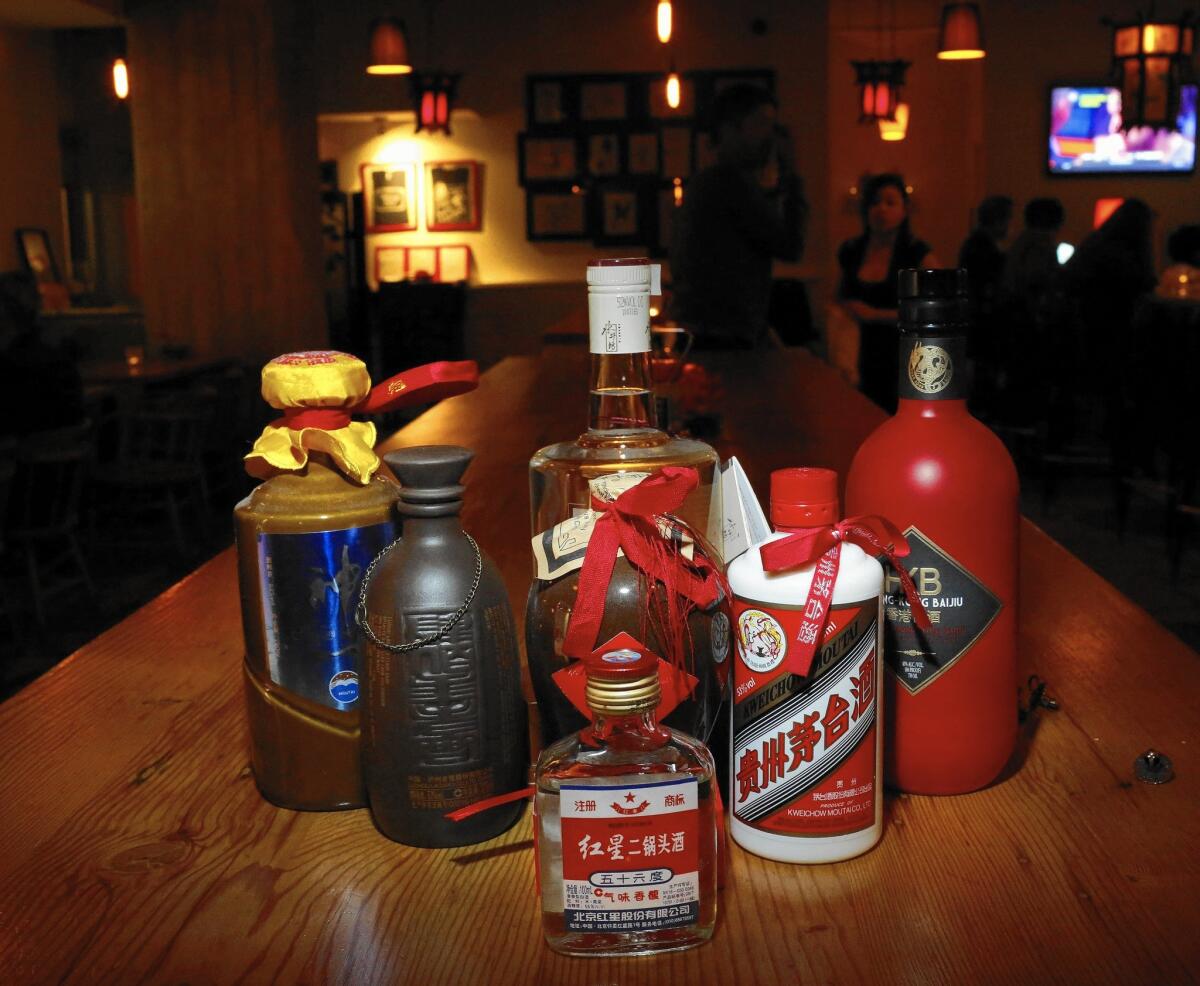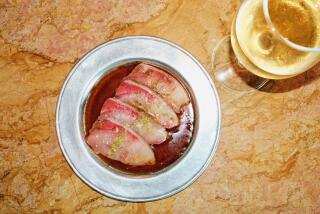The world’s most-consumed alcohol: baijiu. Never heard of it? Here’s where to try it in L.A.

At Peking Tavern, a Chinese gastropub in downtown Los Angeles, there’s a section behind the bar devoted exclusively to the most consumed alcohol in the world: baijiu. If you’ve never heard of it, you’re not alone. The spirit is China’s national drink but has only recently gained traction in America, due in no small part to publicity boosts from global liquor companies with Chinese interests.
Multinational alcohol company Diageo added Shui Jing Fang baijiu to its portfolio five years ago; it comes from Sichuan, where it has been made continuously for more than 600 years. In northern China, the unique flavors of baijiu, which is pronounced BYE-jo and translated literally as “white spirit,” are steeped in tradition and acceptance. In America, baijiu’s unfamiliar profile is polarizing. Open a bottle and you’ll smell something akin to Juicy Fruit chewing gum, but savory — the sweet liquor tastes of cherry and pineapple at first, then transforms from fruity to funky, settling on the palate with a smoky, gamey slam.
Join the conversation on Facebook >>
The stuff is called “Chinese firewater” for good reason — the clear liquid, distilled from sorghum and other grains, weighs in at a whopping 50% to 55% alcohol by volume. A dangerous prospect, because it feels smoother than lower alcohol spirits when you knock it back.
There are four broad classifications of baijiu — light, strong, complex and rice — from thousands of regional distilleries. Despite being served in tiny ceramic cups or small stemmed glasses, the Chinese consume this white spirit in large quantities. During a celebratory meal, particularly in business and government circles, someone will order a high-end bottle of baijiu. (It is never served by the glass in China.) Each diner is expected to toast the host, then lower his glass to show humility and respect. “Ganbai!” is the appropriate toast, said Andrew Chiu, co-owner of Peking Tavern. It means “bottoms up!”
“When you drink baijiu together at a banquet or to close a business deal it’s like saying, ‘Now we are brothers,’” says Chiu. Often seen as a luxury item and gifted like vintage Cognac, baijiu is not exclusive to the upper class. In Beijing, where Chiu lived in the 1990s, laborers and factory workers consumed small bottles of cheap, boozy Erguotou baijiu with lunch.
Transplanted Chinese communities in Los Angeles County, which has the largest population of northern Chinese in the U.S., typically consume baijiu in their homes.
Lately, baijiu has become popular in bars and restaurants largely due to the efforts of CNS Imports, a wholesale distribution company that has supplied baijiu brands in America for more than 30 years.
“Some baijiu brands have cleaned up their look to attract younger generations,” said CNS general manager Shawn Shih recently over lamb pot stickers and Sichuan fish dumplings at Peking Tavern. He’s referring to HKB, a brand of baijiu that he recommends for mixing in cocktails.
Peking Tavern, which opened in a basement on Spring Street in 2013, was one of the first places in the U.S. to offer a wide selection of baijiu. Here, Red Star baijiu, the most popular brand in Beijing, is mixed into drinks and often accompanied by a plate of dragon fries. “American Chinese don’t realize how much drinking and eating go together,” said Chiu. “We wanted to offer authentic northern Chinese dishes to accompany baijiu, which accentuates the food.”
There’s another reason baijiu manufacturers want to see global baijiu consumption increase. Sales of luxury goods in China remain sluggish after anti-corruption campaigns began in 2012. Jeff Cioletti, author of “The Year of Drinking Adventurously,” wrote in an email, “The [Chinese] government’s been cracking down on ostentatious displays of wealth. The high-end baijius often were given as gifts by dignitaries and high-rolling business people as a sign of status.” Maotai, a luxury brand of baijiu, has diversified its offerings since the campaign began. “But now, no one can be giving expensive gifts anymore so it’s taken a bit of a hit there,” Cioletti added. “That’s why they’re doubling down on the U.S. market.”
Sampling baijiu cocktails around Los Angeles is easier than ever. Magnolia House in Pasadena recently featured baijiu in a cocktail seminar. Its Siu Yeh (midnight snack) is made with Shui Jing Fang baijiu, Lillet Blanc, amaro Montenegro, angostura and orange bitters, and finished off with an aquavit rinse. Baijiu isn’t background noise in this drink. “You get sour plum, dried raisin and Twizzlers — oddly enough — all accompanied by an underlying bitter sweetness that’s more than pleasant the whole way through,” said bar manager Brian Klemm.
Not all drinkers are prepared for baijiu’s unique profile. At Wood and Vine, an upscale bar and restaurant in the heart of Hollywood, a baijiu martini with orange flower water was too much for mainstream palates. “We tried an experiment with Shui Jing Fang baijiu,” says beverage director Gregory Austin, “which the staff and our more adventurous guests really enjoyed. Unfortunately, due to the pungency of Shiu Jing Fang, we had too many of them returned for us to continue to offer it. Hollywood Boulevard is simply not ready for all that intensity of flavor and aroma.”
At least the part of the main boulevard so close to the tourist heart of Los Angeles — but venture away from the city’s landmarks and the thirst for baijiu, and complexity, seems unquenched.
ALSO
Chinese New Year meals in L.A. aren’t strictly traditional
Cherimoyas are at the market. Here’s what to do with them.
Pho, Spam musubi and more emerge from the window of this food truck
More to Read
Eat your way across L.A.
Get our weekly Tasting Notes newsletter for reviews, news and more.
You may occasionally receive promotional content from the Los Angeles Times.








